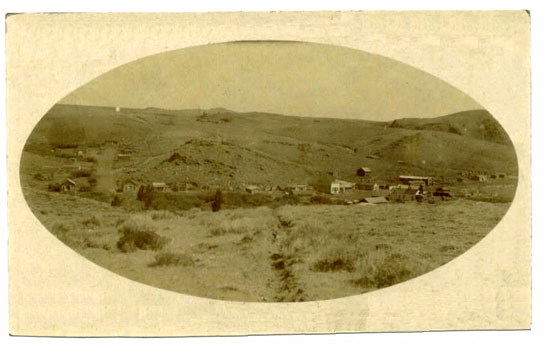
South Pass City, 1911
In the two-year period from 1868 to 1870, South Pass City arose from an abandoned stage stop to one of the
largest cities in the Territory. Its fall was equally swift. In his 1874 Report, the United States Commissioner of Mining Statistics,
Dr. Rossiter W. Raymond, commented:
South Pass City is nearly deserted, all of the numerous ledges surrounding it now lying idle.
The celebrated Cariso mine, from which so much bullion was taken in 1869 and 1870, was
disposed of by Mr. Roberts in the fall of 1870. The English company, owners of the-Irishman
ledge, became the purchaser, paying $15,000 down, and agreeing to pay $115,000 more in
monthly installments. After being put in possession of the mine, it was ascertained that
they were not only unable to pay for the mine, but also to work it. They had evidently
bought it on speculation, hoping their stock could be sold on the record of the Cariso.
Since that time nothing has been done on the mine.
The Young America is also idle, the company having become disheartened by the loss of their
valuable mill. The mine is well opened, exhibits a vein averaging 2 feet in width, and
yields, by ordinary stamp process, about $15 per ton.
The other mines in this vicinity are similarly situated. They are all idle, and their
locators are absent in Utah, prospecting for silver and lead mines.
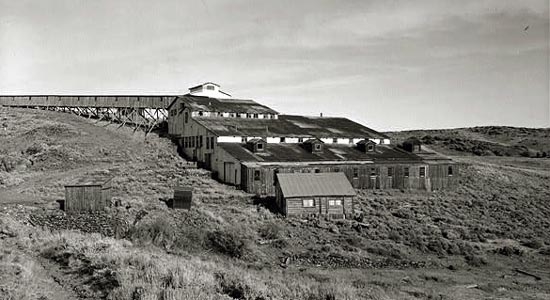
Carissa Mine, South Pass City. Photo courtesy Library of
Congress
In 1901, the Carissa was reopened and the shaft extended to 300 feet in depth. Ultimately the mine was increased in
depth to 387 feet with five levels. Nevertheless, by 1906, the mine was again closed. In 1946, the mine was again
reopened, but again closed.
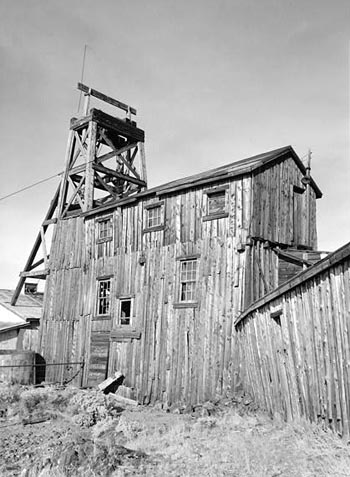
Hoist house, Carissa Mine. Photo courtesy Library of Congress.
The original hoist house burned in 1873. It is uncertain as to the date of construction and it may date to either the
1873 period or the 1901 reopening of the mine. The Carissa Mine has now been acquired by the
State. In addition to the Carissa, other mines near South Pass City included
the Barr Mine,
Carrie Shields Mine,
Duncan Mine,
Empire State Mine,
Franklin Mine
Gould & Curry Mine (Carter Lode),
Mohamet Mine,
Wyoming Mining Company Mine, and
Young America Mine.
ONE SHOULD NOT EXPLORE OLD MINES. NOT ONLY IS IT
DANGEROUS, BUT WITHOUT PERMISSION OF THE OWNER, IT MAY CONSTITUTE CRIMINAL TRESPASS!
It is not that the owners are unfriendly, they are avoiding potential liability in the event of an
untoward accident.
Gold in the South Pass area was deposited within the rocks some 2.8 billion years ago toward the
end of the Archean Period (4 billion to 2.5 billion years ago). During the Archean Period, the Earth
was more tectonically active with micro-continents rapidly moving on the various tectonic plates. The micro-continents
collided with each other forming larger continents. In what is now western Wyoming, an arc of
volcanic islands was separated from one such micro-continent by a deep trench. Into the trench would be deposited
layers of sedimentary rock and lava flows containing green minerals giving
the rock a greenish tint ("greenstone"). As the tectonic plates floated over the earth's mantle,
the arc of islands collided with the continent, folding, fracturing, and splintering the rocks that previously had been in
the depths of the primeval sea. And from the depths of the Earth, molten volcanic rock worked its way through paths of
least resistence upwards through the layers of sedimentary rock. The heat and pressure changed the rock and caused it
to recrystalize into metamorphic rocks. Fluids carried various minerals such as copper, gold, and
platinum and concentrated them along the edges of split rock and into the veins and crevices formed by the
collision. It has been estimated that over 50% of all gold ever mined since
the beginning of time was deposited in this manner. As a result of the
collision, mountains arose in the same manner as the Himalayas of today are being formed by the
collision of India with Asia.
Over the 2.5 billion years, the mountains eroded exposing the greenstone and the intrusions of
volcanic rock. From the exposed veins, particles of gold were washed into
adjacent streams and lodged in beds of gravel and sand awaiting discovery by prospectors moving
eastward from California. The prospectors followed the traces of yellow in the stream
beds upstream to find the exposed veins of the concentrated gold. Others engaged in placer
mining along the gulches and stream beds where the gold had been deposited.
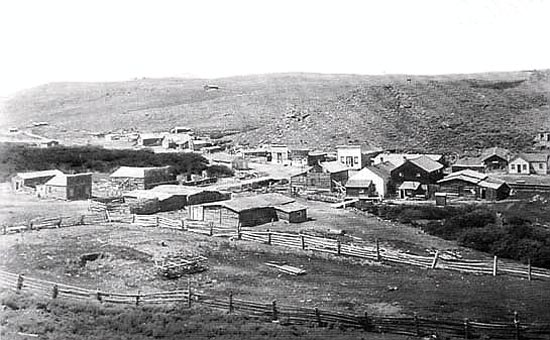
South Pass City, 1906
The log barn in the foreground is the Black Horse Livery Stable constructed by George
Dean about 1868.
Prior to the gold rush, South Pass "City" consisted of little more than a stage stop on the
route through South Pass. Mark Twain in Roughing It described his passage
through the city:
Toward dawn we got under way again, and presently as we sat with raised curtains enjoying our
early-morning smoke and contemplating the first splendor of the rising
sun as it swept down the long array of mountain peaks, flushing and
gilding crag after crag and summit after summit, as if the invisible
Creator reviewed his gray veterans and they saluted with a smile,
we hove in sight of South Pass City. The hotel-keeper, the postmaster,
the blacksmith, the mayor, the constable, the city marshal and the
principal citizen and property holder, all came out and greeted us
cheerily, and we gave him good day. He gave us a little Indian news,
and a little Rocky Mountain news, and we gave him some Plains
information in return. He then retired to his lonely grandeur and
we climbed on up among the bristling peaks and the ragged clouds.
South Pass City consisted of four log cabins, one if which was unfinished,
and the gentleman with all those offices and titles was the chiefest of the
ten citizens of the place. Think of hotel-keeper, postmaster, blacksmith,
mayor, constable, city marshal and principal citizen all condensed into
one person and crammed into one skin.
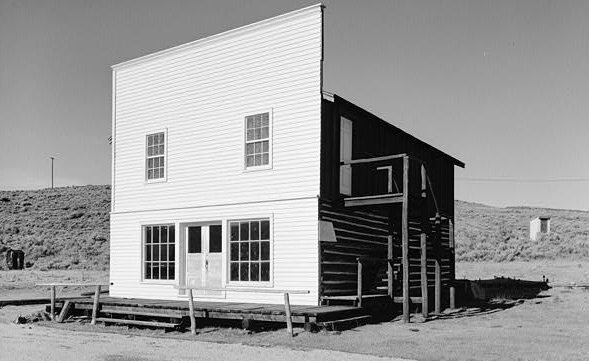
Masonic Lodge, South Pass City
The lodge received its dispensation from the Grand Lodge of Nebraska in 1869 and, thus, became the
first Masonic lodge in Wyoming. The building depicted is a reconstruction which was sponsored by
Lander Lodge. For discussion on history of
the Masonic Order see discussion on Cheyenne III.
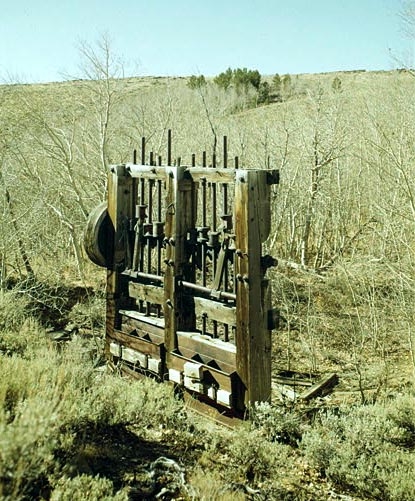 Abandoned mining machinery near South Pass City
Abandoned mining machinery near South Pass City
The mining machinery depicted are the remains of the Palmetto Gulch Crushing Mill at South Pass City.
As noted, the Iliff Bank closed in
1870. At the same time disputes
arose with Green River City as to the location of the county seat with, pending an
election, the Board of County Commissioners meeting first in South Pass City, then
in Green River City, back to South Pass City. When the election was held Green
River City won, but it still required a law suit against the Board to get
the move made. Meanwhile, in the various moves back and forth, some of the County's
financial records were stolen. In 1871, a fire destroyed several buildings including
the newspaper. As previously noted, the most important mine, the Carissa closed in
1873. The result of the fire, loss of the county seat and the coming of
the railroad to Green River, bypassing the town, was the town's failure. By 1880, the town population had
declined to a total of 37 men, women, and children. Among those holding on was poor
Tom Ryan who had lost his claim to the Carissa. In 1884, South Pass City, once the county
seat of Sweetwater County, became a part of Fremont County.
South Path City is also noted as the home of woman's suffrage. In 1869, William H. Bright, South Pass
mine and saloon owner, was elected to the First Territorial Assembly. He introduced a bill providing for
woman's suffrage which was passed by the Democratic controlled legislature and sent to Republican Governor John A.
Campbell who approved the bill. Various versions are given for the motivation for
Bright to introduce the bill. One is that Bright was persuaded to do so by a
promise made to Esther Morris, later the first woman justice of the peace in the
United States. Another is that Bright was influenced by his wife, Julia, to introduce the
act. A third, probably finding its origin in an article written by Territorial Justice
E. A. Thomas, was that the motivation was an effort by Democrats to embarrass Governor
Campbell. A modification of that theory is that the Democrats thoughy that the women would
vote Democratic and would offset Black voters who tended to vote
Republican. If that was the motivation it backfired since this was before the days
of the "Australian" or secret ballot, and it was soon discovered that the women tended to
vote Republican. Thus, two years later the Democratically controlled legislature attempted
to repeal woman's suffrage, but the act of repealer was vetoed by the Republican Governor. By
that time enough Republicans had been elected to sustain the veto.
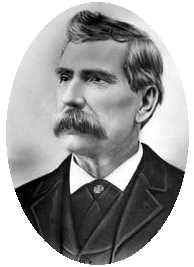 William H. Bright
William H. Bright
Some authorities tend to downplay Bright's impact or significance in the passage of the bill and
to emphasize the influence of Mrs. Morris. As an example, Nancy Kohlhoff of the
Indiana American Association of University Woman has attributed the introduction and passage of the bill to Mrs. Morris:
Esther Morris was in South Pass City in 1869, a town of about three thousand
people not far from Cheyenne. She had followed her husband and sons to the
frontier from Illinois. Having heard Susan B. Anthony speak on woman
suffrage before leaving the Midwest, Esther was an advocate of woman’s
rights including the right to vote.
When Esther heard that her "town" was preparing to elect delegates to the
first Territorial legislature, she invited twenty of the most influential
men in the vicinity to her "shack" for dinner. During the evening, she
pleaded the cause of woman suffrage so eloquently that each of the men
promised, if elected, to include a woman suffrage clause in the Territorial
laws and provisions.
William H. Bright was elected president when the Council met in October 1869.
He immediately introduced a woman suffrage bill, which was passed without
discussion. In the territorial House, however, "the bill was opposed by a
determined Mr. Ben Sheeks, who apparently had not been invited to Mrs.
Morris’s dinner party." Finally, the bill passed with only one qualification
"a woman must be 21 years to vote."
Statues of Mrs. Morris have been placed in
the Capitol in Washington and in front of the State House in Cheyenne.
The above quotation is accurate in that the qualification that a woman had to be 21 was added
to the bill and Ben Sheeks, also from South Pass City, opposed the Act. There was, however, as pointed
out by Professor Larson, considerable
discussion in the press of the day, and efforts were made to add to the bill provisions permitting "squaws" to
vote. The population and distance from Cheyenne of South Pass City is somewhat
inaccurate. Bright himself, although from Virginia, had served in
the Union Army during the Civil War and came to Salt Lake City before moving to
South Pass City during the 1868 Gold Rush. There, as above noted, he was elected to
the Assembly and was elected as the President of that body. Contemporaneous sources
give credit to Bright. After the gold rush in South Pass ended, Bright left the
Territory for Denver.
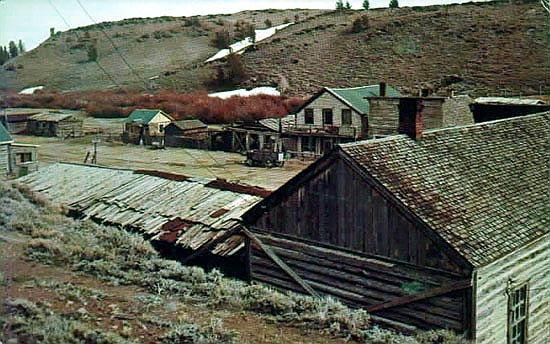
South Pass City.
Professor T. A Larson in his History of Wyoming has commented:
One who introduces a bill normally gets credit for it, and this was true for
Bright as long as he was around to defend himself. Two months after the act was adopted, the
Cheyenne Leader gave him full credit for it and remarked that "Bright,
of Wyoming, is already immortal." For the next twenty years he was generally
recognized as the person mainly responsible for establishing woman suffrage in Wyoming. Beginning in 1889,
long after Bright had left the territory, Mrs. Esther Morris moved from a place in the
wings, barely visible, and began to nudge Bright from the center of the
stage. Before Mrs. Morris' partisans were through, Colonel Bright was in
the wings, barely visible, and Mrs. Morris was sole occupant of the center of
the stage."
Next Page: Atlantic City.
|